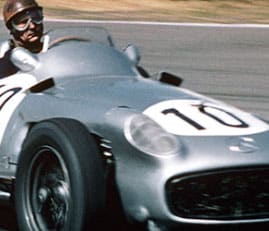He made fastest time in the Friday morning test-session, fastest time in the Friday Qualifying period, fastest time on Saturday morning, fastest again in Saturday Qualifying, fastest in the Sunday morning “warm-up” session, and fastest lap in the race which set a new record for the new Silverstone circuit. His pole position lap was at a speed of 144.420 mph, his race average was 131.227 mph and his lap record was 135.325 mph. Nigel Mansell was the undisputed master of the whole three days of the British Grand Prix, and he used a Williams FW14 car powered by a Renault V10 RS3 engine.
Mansell and Senna on the front row at the start of the race
Where were all the rest? They were all there in great force and trying hard but failed to stop the meteoric flight of the Boy from Birmingham. The Williams-Renault team had begun to show their true potential at the San Marino GP, and then at Monaco. By the time of the Canadian GP the warnings to McLaren/Honda/Senna were clear and by Mexico defeat of the all-conquering Anglo-Japanese team was a fact, to be hammered home in the French GP. At our own Grand Prix at our “home of motor racing” the domination was complete. It did not arrive over-night but is the result of Williams and Renault, together with all their supporters and suppliers, keeping hard at it to gain a tiny advantage here, another there, a one percent improvement on this and a one percent improvement on that on the myriad of components that go to make up a modern Formula One car. It would be too simple to say that the Williams chassis is better than the McLaren, or the Renault V10 engine develops more power than the Honda V12. It is minute attention to every aspect of a racing car that might show a small improvement over the opposition. While Patrick Head and Adrian Newey work away on the car and all its complexities, and the aerodynamics, Bernard Dudot and the Renault engineers work away at engine development, not just in the search for more horsepower and more torque, but more efficiency coupled with more economy, allowing the Williams to start the race with less fuel load for example. If the aerodynamics are more efficient than the opposition then Renault power can be used for other things than overcoming air drag, or if the opposition have to use more of their horsepower to overcome higher drag for the same ‘down-force’ and cornering power, so much the better, and if the Williams driver can save one hundredth of a second on a gear change, then in 100 gearchanges he already has a second advantage. This minute advantage on all fronts is the way Williams and Renault have been approaching their joint Formula One venture in perfect harmony.





